Exploring the Depths of Partner Tarot Reading
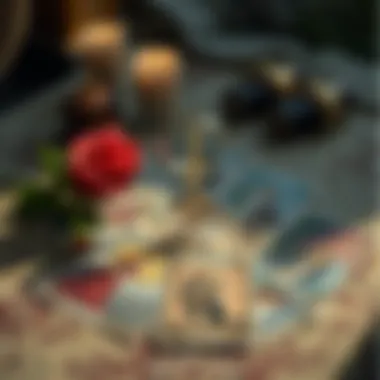
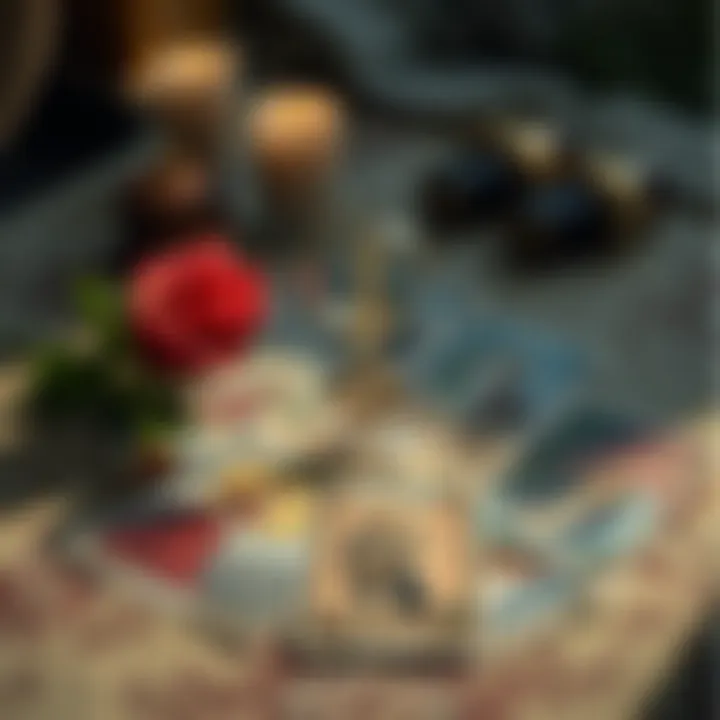
Intro
The intimate art of partner tarot reading opens a doorway to understanding not only ourselves but also the people we hold dear. As individuals navigate their romantic relationships, this ancient practice helps to illuminate the intricate webs we weave with our partners. Why is tarot reading particularly relevant in the realm of partnerships? Well, it provides a lens through which we can examine our emotional landscapes, desires, and, ultimately, our connections.
In this article, we'll unpack the significance of partner tarot reading, delve into the various approaches employed by practitioners, and explore how these practices can enhance relational dynamics. By blending historical context with practical methodologies, readers will emerge with a richer understanding of how to incorporate tarot reading into their relationships for personal growth and nurturing connections.
Prologue to Partner Tarot Reading
Partner Tarot Reading serves as a unique lens through which individuals can gain insights into their relationships. It is not merely about forecasting the future; rather, it acts as a reflective tool that helps partners navigate the complex dynamics between them. The essence lies in understanding one another on deeper levels, fostering communication, and unveiling hidden thoughts or feelings that might otherwise remain unspoken. As relationships evolve, having a mechanism that promotes clarity and insight becomes immensely valuable.
Defining Partner Tarot Reading
Partner Tarot Reading entails using a standard tarot deck with the specific intention of exploring the nuances of a romantic relationship. This practice is about much more than predictions; it focuses on understanding themes within the connection—emotional patterns, potential challenges, and mutual aspirations. Each card pulled can serve as a metaphorical mirror, reflecting not only the individual personalities involved but also the relationship's essence. For instance, drawing The Lovers card might highlight a critical choice ahead for the couple, whereas The Two of Cups can indicate harmony and partnership.
Relevance in Contemporary Relationships
In today’s fast-paced world, relationships often face unique stresses and transitions. Partner Tarot Reading is particularly relevant because it offers a framework for honest discussions without the weight of societal judgments or expectations. Participants can engage with the cards' messages, generating dialogues that might be hard to initiate in conventional settings.
- Fostering open dialogue is crucial, as many couples battle with miscommunication or suppressed emotions. Tarot provides a safe space to explore these issues.
- Understanding shared energies helps each partner see the bigger picture, making it easier to work collaboratively towards relationship goals.
"The cards speak to us, but we must be willing to listen to what we hear, and the silence that they sometimes leave behind."
Additionally, as astrology enthusiasts often seek deeper meanings and insights in life, Partner Tarot Reading complements these pursuits perfectly. It encourages individuals to look within themselves while simultaneously seeking to understand their partners. This dual focus not only enhances personal growth but contributes to healthier relational dynamics.
Historical Context of Tarot
When diving into the realm of partner tarot reading, understanding the historical context of tarot itself is crucial. Tarot cards are not just tools for divination; they represent a rich tapestry of cultural evolution, artistic expression, and psychological exploration. Knowing where tarot comes from can illuminate its significance in our relationships and offer deeper insights into the very readings that we perform today.
Origins of Tarot Cards
The roots of tarot can be traced back to the 15th century, primarily in Europe. What started as a simple playing card game in Italy gradually morphed into a more complex divination system. The early tarot decks were not created with the intention of fortune-telling; instead, they served a more recreational purpose. The Visconti-Sforza deck, which dates back to around 1450, stands as one of the oldest surviving examples, showcasing not just art but also the shifts in social dynamics of the time.
As people began to attach symbolic meanings to these cards, they slowly transitioned toward the spiritual and the metaphysical. The Tarot of Marseille, for instance, is a noteworthy variant showcasing this symbolic richness and is deeply intertwined with French cultural history. Originally, the major arcana depicted biblical and mythological figures, but as the usage expanded, it began embracing various interpretations influenced by humanist ideals and folklore.
The fascination with tarot continued to grow, especially during the Renaissance. Artists flourished, infusing their perspectives and beliefs into new decks. This melding of art and spirituality laid the groundwork for the tarot becomes a popular tool for self-reflection and guidance in modern times.
Evolution of Tarot as a Divination Tool
Over the centuries, the transformation of tarot from mere cards to a pivotal divination tool showcases its adaptability and significance. By the late 18th and early 19th centuries, tarot began to shed its association with mere gaming, entering the realm of mysticism. Figures such as Antoine Court de Gébelin and Jean-Baptiste Alliette (known as Etteilla) were monumental in weaving the magical narrative around tarot, establishing it as a means to gain insight into one's life and future.
In this era, tarot was marketed not just as a game but as a serious tool for introspection and decision-making. The introduction of esoteric associations with the Kabbalah and astrology added layers of complexity to the readings and interpretations of cards. This evolution was not just a change in perception; it opened the door for individuals to explore their psyches in relation to their relationships.
With each epoch, tarot embraced and integrated cultural shifts, becoming a reflection of the societies that practiced it. Today, the profound impact of cultural beliefs can still be seen in various tarot decks worldwide, each offering unique perspectives shaped by heritage and collective experience.
As we look toward partner tarot readings, the historical backdrop is a reminder that these cards have journeyed through time, adapting to serve the needs of those seeking a deeper understanding of themselves and their connections with others.
"Understanding the historical roots of tarot cards enriches our comprehension of their purpose in partner readings."
In essence, the historical context of tarot provides a lens through which to view not just the cards and their meanings, but the intentions and insights they offer. This background knowledge is essential for anyone curious about the intricate dynamics of partner tarot reading.
The Mechanics of Tarot Readings
Understanding the mechanics behind tarot readings is crucial for anyone looking to delve into partner tarot reading. It’s not just about shuffling cards and laying them out; there’s a rich tapestry of symbolism, intuition, and methodology at play. The mechanics encompass the tarot deck itself, the various spreads used, and how one navigates the nuances of interpretation. This section aims to break these elements down to illuminate their importance and how they contribute to gaining insights in a relationship context.
Understanding the Tarot Deck
The tarot deck is the fundamental tool of any reading, with each card holding a specific significance that resonates with the querent’s (the person receiving the reading) situation.
Major Arcana
The Major Arcana consists of 22 cards that represent significant life lessons and archetypal energies. A striking feature of the Major Arcana is that these cards often reflect profound themes impacting one's life journey—think of foundational changes, personal transformations, or major relational dynamics. In partner tarot readings, these cards provide a more profound insight into the essential issues that may be affecting a relationship's course.
These cards are often seen as more influential; when a Major Arcana card appears in a reading, its message might carry more weight, indicating that the situation at hand is of considerable importance. However, due to their intensity, interpreting these cards can sometimes lead to feeling overwhelmed, and requiring careful consideration thus while reading within relationship contexts.
Minor Arcana
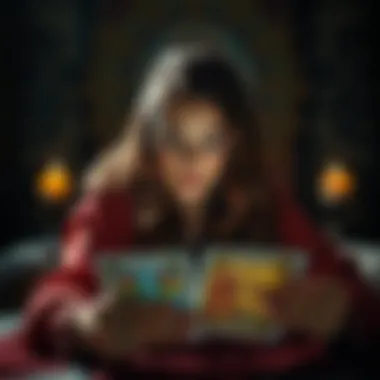
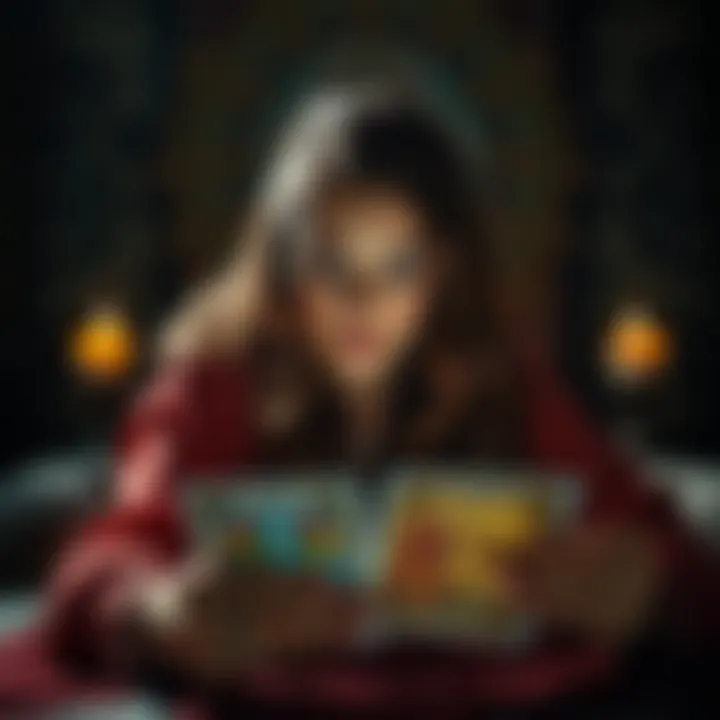
On the other hand, we have the Minor Arcana, consisting of 56 cards that delve into the day-to-day aspects of life. They are categorized into four suits—Wands, Cups, Swords, and Pentacles—addressing various realms of existence like emotion, intellect, creativity, and materiality. The beauty of the Minor Arcana lies in its ability to paint the nuances of everyday interactions, highlighting how the tiny ripples in our day-to-day life can culminate into significant waves in relationships.
While these cards may seem less impactful than the Major Arcana, they are crucial for providing context in partner readings. They spotlight the immediate issues that may arise between partners, allowing for a comprehensive view of a situation. However, because they deal with more mundane matters, it's essential not to dismiss their significance.
Tarot Spreads for Partner Readings
Tarot spreads are structured layouts used to facilitate readings. Each spread serves a purpose, enabling seekers to focus on questions and insights relevant to their relationship.
Three-Card Spread
The Three-Card Spread is popular for its simplicity and versatility. Typically, each card represents a different aspect of a relationship—past, present, and future. This structure allows the reader to directly connect the relationship's evolution, making it a beneficial choice for those looking for a quick yet profound understanding of their partnership.
Its unique feature lies in its straightforward nature, letting both the reader and querent dive into past influences on the relationship dynamic, current states of affairs, and future potential. However, the challenge here can be the risk of oversimplification, as complex relationship dynamics might need a more elaborate analysis.
Relationship Spread
The Relationship Spread digs deeper into the interaction between two partners by assessing each individual's feelings, challenges, and strengths within the partnership. This spread shines in its capacity to delineate distinct roles and emotions in the relationship, often revealing unspoken issues that can affect connection.
Essentially, this spread is tailored for relational insights, which makes it a beneficial choice for partners seeking clarity. Nonetheless, the breadth of details it offers can sometimes lead to confusion if both partners are not on the same page about the reading.
Celtic Cross
The Celtic Cross is a classic and expansive spread that offers in-depth insights into the relationship’s challenges, strengths, and complexities. This spread is characterized by ten positions that encompass various aspects, such as external influences, hopes, and fears. It’s a comprehensive tool, ideal for those who need a deep dive into their dynamic.
Its key characteristic is its capacity for detail, making it suitable for individuals looking for thorough guidance. However, interpreting such a complicated layout requires a seasoned reader to navigate adeptly through various meanings, which could inadvertently lead to overwhelm if not approached correctly.
"Understanding these spreads and their mechanics is invaluable for drawing meaningful conclusions from your readings."
In summary, grasping the mechanics of tarot readings—be it the profound meanings of the Major and Minor Arcana or the practical applications of specific spreads—provides a solid foundation for any partner tarot reading. Each element can unveil layers of insight into relational dynamics, allowing connections to flourish and personal growth to emerge.
Interpreting Cards in Context
Interpreting the cards in a partner tarot reading holds great significance, as it forms the crux of what tarot really aims to offer—insight into relational dynamics and personal growth. When readings are approached thoughtfully, the meanings behind the cards can serve as a mirror to the complexities of human relationships. They allow individuals to explore their current situation and gain deeper understanding, sometimes revealing aspects that may have been overlooked. In this section, we will delve into specific cards and their symbolism while considering how different interpretations can affect insights gained from the readings.
Symbolism of Key Cards
Each tarot card comes with its unique story and symbolism, and understanding these is essential for contextual interpretations during partner readings. A few cards tend to pop up frequently due to their strong representations of love, connection, and long-term commitment.
The Lovers
The Lovers card is often seen as a beacon of romantic connection. It symbolizes not just love but also choices and alignment in relationships. One of the key characteristics of this card is its duality, embodying not just a romantic partnership but essential decisions that partners may face. In the context of partner tarot readings, The Lovers offers crucial insights into the harmony or discord between partners and their ability to unite versus diverge.
What makes this card particularly valuable in readings is its ability to push individuals to reflect on the deeper aspects of their relationships. However, a challenge arises when interpreting it; if read incorrectly, it might suggest an idealized version of love that doesn't reflect reality. Therefore, understanding the nuances at play when this card appears is vital. Its presence can urge partners to confront their choices with awareness and intention.
Two of Cups
The Two of Cups goes hand-in-hand with the idea of partnership and mutual respect. It symbolizes the emotional bond between two individuals, suggesting a harmonious relationship marked by balance and sharing. Among tarot enthusiasts, this card is a popular choice for partner readings due to its emphasis on connection and empathy. Its core feature is the sentiment of partnership, encouraging collaboration in relationships.
That said, one must remain cautious of its overly romantic implications. While it often hints at union and love, it can also signify the need for balance—a reminder that both partners must invest equally. The Two of Cups is beneficial when both individuals wish to deepen their understanding of their unity, but it can take a turn if one partner feels overshadowed or unequally treated.
Ten of Pentacles
The Ten of Pentacles represents long-term stability and security within a relationship. This card signals that a relationship can grow to have a lasting legacy, often focusing on family, traditions, and shared goals. In partner readings, this card underscores the importance of commitment and the evolution of relationships over time. Its key characteristic is the ability to envision a future together, linking love to practical considerations.
However, while it leans heavily into the positive aspects of security and stability, it can also pose its own set of challenges. If one partner is gung-ho about long-term plans but the other is hesitant, it can lead to incongruences in vision, creating tension. Thus, understanding its presence in a reading can help clarify where each partner stands when it comes to future aspirations.
Positive vs. Negative Interpretations
Interpreting cards in a reading is not black and white; it’s crucial to weigh positive insights against potential challenges. Positive interpretations can serve as encouraging pointers that indicate growth and support within a relationship, while negative readings can highlight conflicts or misunderstandings that need addressing. This complexity adds depth to the tarot experience and allows individuals to prepare for various outcomes. Each interpretation, be it positive or negative, feeds into the broader narrative of the reading, facilitating an open-ended conversation about the personal dynamics at play.
"The essence of tarot lies not just in foretelling the future but in unveiling the deeper truths of relationships as they currently stand."
In summation, the context in which tarot cards are interpreted plays an essential role in the meaning extracted from each reading. By exploring key symbols and remaining mindful of varying interpretations, partners can navigate their relationships more effectively, with the tarot acting as a guide.
The Role of Intuition in Readings
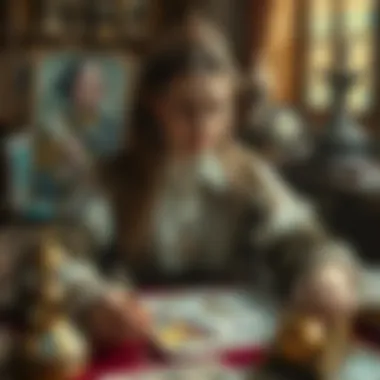
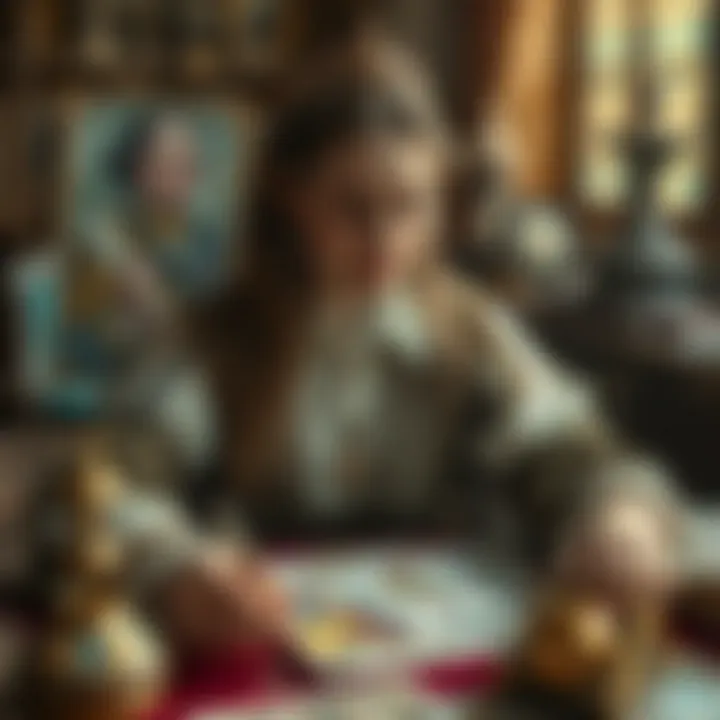
When it comes to partner tarot readings, the role of intuition cannot be overstated. Intuition is that intrinsic ability to grasp something without the necessity for conscious reasoning. It’s the little voice that whispers "pay attention" or "something doesn’t feel right." In the context of tarot, intuition can often be the guiding factor, helping to unveil deeper meanings behind the cards. While conventional interpretations and meanings of cards provide a framework, intuition takes it a step further. It adds a personal touch, making readings more authentic and tailored.
Intuition becomes particularly vital between partners when they engage in tarot readings together. During such readings, both individuals bring their perceptions and feelings to the table, which can alter the way a card is interpreted significantly. The shifting dynamics of the reading are quite reflective of real-life interactions in relationships – what might focus solely on objective meanings in isolation changes when two minds come together.
Developing Intuition for Tarot
Understanding how to develop intuition for tarot reading involves a few key practices. One of the most effective methods is meditation. By allowing the mind to rest and clearing away distractions, you create a space conducive to heightened awareness. Here are several practices that can help enhance your intuition:
- Daily Card Pulls: Draw one card each day and reflect on what it may mean in your life. This not only familiarizes you with the cards but helps train your intuition to find connections between circumstances and tarot symbols.
- Keep a Tarot Journal: Document your pulls, interpretations, and any intuitive insights. Over time, you might observe patterns and personal nuances in your interpretations.
- Connect with Your Emotions: Pay attention to feelings evoked by certain cards. A card that might seem straightforward could hold biases or preferences; your instinct can offer crucial clarity on these emotions.
- Participate in Readings: Engaging with others in tarot readings allows you to see how different interpretations can emerge, aiding your intuitive understanding.
Trusting Your Insights
One of the more challenging aspects of intuition in tarot is learning to trust your insights. Often, people second-guess themselves, dismissing their intuitive nudges as mere imagination. However, within the realm of partner tarot reading, these insights can be pivotal. Trusting your intuition means respecting that inner voice that captures the essence of the moment. Here are a few considerations to keep in mind when learning to trust your intuition:
- Experience: Understanding that every reader generates a unique relationship with the cards helps in trusting insights. Over time, as you reflect on previous readings, you’ll see how your intuition has guided you accurately in numerous situations.
- Being Present: Staying focused during the reading ensures that you’re not only listening to the cards but also tuning into your feelings and thoughts. This attention creates deeper connections with the cards.
- Allow Flexibility: Sometimes, your interpretation may not resonate with the person you’re reading for. This is okay. Be open to discussions; this process enriches both partners' insights and maximizes learning opportunities for future readings.
"Intuition does not come to an unprepared mind." - Albert Einstein
Cultivating intuition in partner tarot readings is a continuous journey of exploration and reflection. As with any skill, practice is key, and each reading you undertake is another chance to deepen your introspective capabilities.
Common Challenges in Partner Tarot Reading
Partner tarot readings can offer deep insights into relationships, but they are not without their pitfalls. Recognizing the common challenges is essential for both readers and querents in navigating the complexities of interpreting relationship dynamics through tarot. Understanding these challenges enhances the accuracy of insights gained and promotes more meaningful discussions between partners.
Bias and Subjectivity
Bias can creep into tarot readings, affecting the interpretation of cards. Readers often bring their own beliefs and experiences into the reading, which can skew the message derived from the cards. For instance, if a reader has had negative experiences with relationships in the past, they may unconsciously project their doubts onto their interpretations. This is especially significant in partner readings, where personal emotions can intertwine with the more objective aspects of tarot.
To mitigate bias, it's crucial for both the reader and the querent to maintain a clear understanding of the reading's purpose. A structured approach, like formulating specific questions, can ground the reading. For instance, instead of asking, “Will we be happy together?” one might frame the question as, “What should we work on to enhance our relationship?” This steering of questions can help focus the reading without the fog of past biases.
Misinterpretations and Misunderstandings
Misinterpretations of tarot cards are also common in partner readings. The advice offered by the cards might be genuine, yet the way it's received can lead to misunderstandings. A classic example could be the Two of Cups, which typically signifies partnership and mutual respect. If misread, one partner might take it as a signal of impending marriage, while the other might see it as implying the necessity for a simple friendship.
Clear, open communication between partners during a reading is pivotal to ensure that everyone is on the same page. It’s advisable that after a reading, partners take time to discuss their individual interpretations. Creating a safe space for dialogue allows for clarifications, enhancing the collective understanding of the cards' messages. Misunderstandings escalate when assumptions are made, thus having a conversation post-reading can avoid the potholes of confusion.
"Understanding each other’s perceptions during a reading can turn profound insights into actionable steps for growth in a relationship."
In summary, challenges like bias and misinterpretations can complicate partner tarot readings. However, acknowledging these difficulties and actively addressing them paves the way for clearer insights and deeper connections for couples. As one dives into the world of tarot, staying vigilant about personal biases and encouraging open discussions can serve as the compass guiding towards meaningful relationship understanding.
Utilizing Insights for Personal Growth
In the rich realm of partner tarot reading, one might often overlook how the insights gained from this practice can serve as powerful tools for personal growth. Engaging with tarot isn't merely about predicting the future or unraveling the mysteries of one's partner; it's about unearthing truths that lie within oneself. By engaging deeply with the symbolism and messages of the cards, individuals can access profound self-awareness and understanding of their relational dynamics.
Reflecting on Relationships
When one reflects on relationships through the lens of tarot, it encourages a thorough examination of what one truly desires and needs. This reflective process can be catalyzed by certain cards drawn during a reading. For instance, the appearance of The Lovers might stimulate a pause to consider: Am I fully aligned with my partner? Is there balance in our relationship?
Utilizing tarot as a mirror through which to view your connections can surface hidden emotions, unacknowledged anxieties, or even unspoken wishes. Here’s how reflecting via tarot can aid growth:
- Uncover Personal Patterns: Certain cards may point towards recurring themes in relationships. For example, the Two of Cups could unveil a pattern where one is drawn to emotionally available partners, while consistently shying away from deeper commitments.
- Enhance Communication: Tarot can serve to illuminate the areas where dialogue is needed. If a reading reveals the need for more openness, individuals might feel motivated to engage in meaningful conversations with their partners.
- Encourage Self-Love: Insights from tarot can lead to a better understanding of personal self-worth. A card like the Ten of Pentacles speaks volumes about legacy and long-term fulfillment, prompting one to reflect on how their historical relationships have built the foundation of their present.
Thus, through reflection, tarot offers a chance for individuals to change perspectives about themselves and their roles within relationships. The act of considering one’s place and feelings encourages personal evolution, ultimately aiding in forming deeper connections.
Implementing Change
Once insights are gathered through reflection, the next step is to implement meaningful change. Realizing patterns and emotions through tarot isn't the end; it’s fundamentally the beginning of action that can lead to transformation.
To effectively implement change based on tarot insights, one can:
- Set Intentions: After a reading that highlights specific relationship dynamics, set clear intentions that guide behaviors and decisions going forward. For example, if a reading points out a tendency to avoid confrontation, an intention might be: "I will engage in conversations even when they feel uncomfortable."
- Develop New Skills: Consider cultivating skills that support change. Whether it's improving communication tactics or learning how to listen actively, these efforts can enhance relationship quality.
- Seek Support: Sometimes, implementing changes can prove challenging. Finding a support group—whether through online platforms like Reddit or personal networks—can provide encouragement and advice.
- Monitor Progress: Maintaining a journal post-readings about the changes you’re making can help you keep track of your journey. This log offers insights into what’s working and what needs adjustment.
- Celebrate Small Wins: Change doesn’t happen overnight, but acknowledging progress—even the smallest of it—can motivate continued effort and commitment to personal growth.
Ultimately, the journey of understanding relationships via tarot isn’t just about solving problems; it’s about embracing an ongoing process of self-improvement and deepening connections.
Through the lens of tarot, relationships can become a powerful avenue for profound personal growth, shifting from mere existence into a vibrant tapestry of shared journeys and discovery. To learn more about tarot and its impact on personal growth, you might explore resources like Wikipedia on Tarot or community experiences on Reddit.
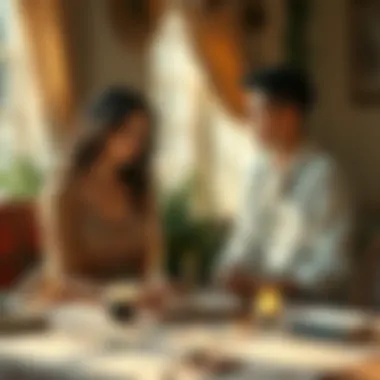
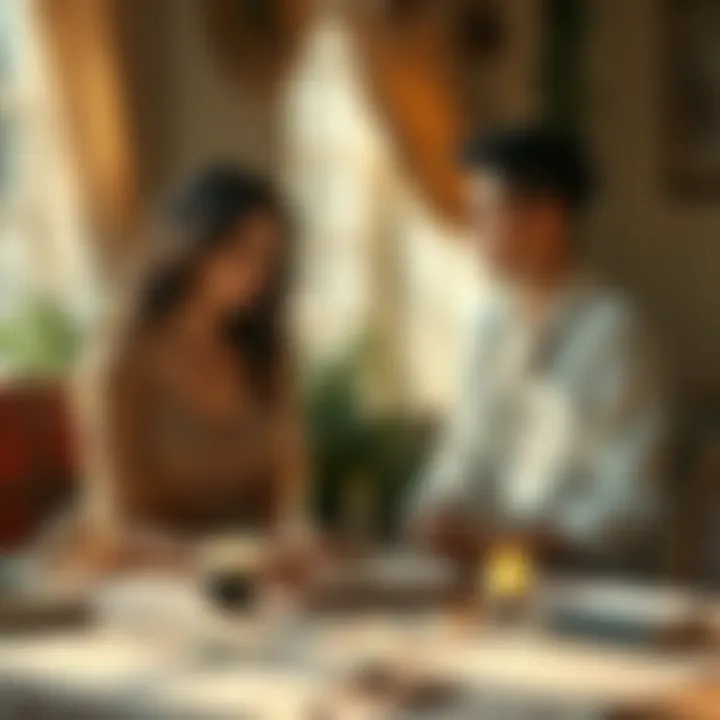
Engaging in personal growth by utilizing insights from partner readings cultivates not only a deeper sense of self but also a richer, more meaningful way to connect with others.
Comparative Analysis with Other Divination Practices
When venturing into the world of divination, it’s compelling to examine how different practices compare and contrast with one another, particularly in the context of partner tarot reading. Understanding these distinctions not only enriches our grasp of tarot but also highlights its unique contributions to relationship analysis. The comparison serves several benefits: it clarifies the advantages and limitations inherent in each practice, provides insights into how they can complement one another, and enables practitioners to tailor their approach according to individual needs.
Moreover, recognizing the nuances in these divination techniques can aid individuals in discerning which method resonates most profoundly with their personal experiences. Deeper insights can arise from the juxtaposition, revealing the paths towards personal growth and relational harmony.
Tarot vs. Astrology
The interplay between tarot and astrology has intrigued many seekers and practitioners in the spiritual community. At a glance, both methods offer illuminating perspectives, yet they stem from different foundations:
- Tarot: Primarily focused on individual situations, the cards draw directly from the reader's intuition and the energy present at the time of the reading. Each card is rich in symbolism and likely to illuminate different aspects of one’s life or relationship.
- Astrology: Rooted in celestial movements and positioning, astrology examines how the positions of planets and stars at the moment of a person's birth shape their personality, behavior, and relationships through astrological signs and houses.
The synergy between the two can be powerful. For instance, a partner tarot reading could uncover dynamics that align with astrological transits, offering insights that might not arise from either method alone. This amalgamation helps individuals gain a more complete picture of their relationship journeys, as they consider not only the immediate situations reflected in their tarot readings but also the broader cosmic influences at play.
Tarot vs. Runes
On the other hand, when comparing tarot and runes, a different set of attributes comes into play. Runes, often associated with ancient Norse and Germanic cultures, utilize symbols carved into stones or wood:
- Tarot: Comprises a deck of 78 cards equally split between Major and Minor Arcana, allowing for intricate storytelling and comprehensive readings.
- Runes: Typically involve a smaller set, often comprising 24 symbols in the Elder Futhark, each possessing specific meanings. Runes often require direct interaction with the physical pieces, adding a tactile aspect to the reading process.
In partner tarot readings, individuals might choose to use runes to complement the emotional insights they gain from the cards. This approach can serve to ground the reading in physical reality, creating a more holistic understanding of their relationship's dynamics. Engaging with runes may also invite a different level of insight as their ancient roots often cultivate a sense of tradition, connection, and reverence.
"In the world of divination, each method is a lens, focusing certain aspects more sharply than others. By embracing multiple views, we can gain a more rounded understanding of ourselves and our relationships."
Combining insights from tarot, astrology, and runes allows individuals to navigate their relationships with greater understanding and depth. Each approach provides unique perspectives that, when woven together, can offer a richer tapestry of insights for personal growth and enhanced relational dynamics.
Community Perspectives on Partner Tarot Reading
The realm of partner tarot reading does not exist in a vacuum. It is greatly influenced by the shared experiences and perceptions of those who engage with it. Understanding how communities interpret and value partner tarot reading presents a richer context for its practical applications. This section aims to explore these communal insights, throwing light on the variations in experiences and the implications of ethics within the practice.
Shared Experiences and Testimonials
Community feedback about partner tarot reading plays a crucial role in shaping the understanding and approach to this practice. Individuals often recount personal stories that highlight the transformative power of a tarot reading. These narratives can reflect a variety of outcomes, from affirmation of feelings and guidance towards communication, to the uncovering of hidden issues that require attention.
For instance, several participants in discussion groups on platforms like Reddit share how a reading offered clarity in tumultuous times. One user reflected, "After a reading, I recognized patterns in my relationships that I was blind to before. It felt like both a wake-up call and a comforting nudge in the right direction." Such testimonials not only underscore the subjective experience but also underline the perceived legitimacy of tarot as a tool for relational insight.
Some common themes arise in personal anecdotes:
- Self-Discovery: Many find that the act of exploring the cards leads them to insights about their own needs and desires, potentially making them better partners.
- Conflict Resolution: There are reports of cards prompting discussions that lead to healthier communication within relationships.
- Validation: Individuals often express feelings of reassurance and guidance post-reading, validating their struggles and decisions.
The community's collective knowledge, shared through forums and social media groups, can be invaluable for both novice and seasoned tarot readers. This shared wisdom can help refine the approach to personal readings and deepen one’s understanding of partner dynamics.
Ethics in Tarot Readings
As in any practice that involves guidance, the ethics surrounding partner tarot readings cannot be overlooked. The fine line between guidance and manipulation must be carefully treaded. It’s vital for readers to hold a space that respects the client’s autonomy, ensuring that advice does not overstep into imposition. An ethical reader views the tarot as a tool for empowerment rather than dictation.
Several considerations come into play:
- Confidentiality: Participants should feel safe sharing personal details, knowing that their trust will be upheld.
- Narrative Empowerment: Practitioners should focus on empowering their clients to make decisions rather than prescribing what must be done.
- Sensitivity to Influence: Readers must be aware of their own biases and ensure that they approach each reading with an open heart and mind, avoiding assumptions based on their own experiences or beliefs.
A community discourse surrounding ethics helps maintain integrity within partner tarot reading. Discussions often revolve around balancing personal insights with the respect of another's free will, which fosters a healthier environment for exploration.
Culmination and Future Directions
Critically, the conclusion and future directions of partner tarot reading serve as a reflection point and a springboard for personal development. This final section encapsulates the significant insights gained through exploring tarot in the context of romantic and platonic relationships. Readers should realize that tarot is more than just a tool for predictions; it’s a conduit for self-reflection and growth. Given the complexities of modern relationships, understanding this practice becomes increasingly relevant.
Summary of Key Insights
Throughout the exploration of partner tarot reading, several key insights emerge that highlight its profound impact:
- Connection to Self: This practice encourages introspection, prompting individuals to assess their feelings, thoughts, and desires.
- Enhanced Communication: Tarot readings often reveal underlying issues in relationships, fostering dialogue between partners.
- Diverse Perspectives: Each card and spread provides a unique angle, allowing readers to approach their relationships from various viewpoints.
- Personal Growth: Interpreting tarot cards encourages individuals to take responsibility for their choices, promoting adaptive change in relational dynamics.
"Every card tells a story, and in those stories, we find our own narrative woven through the cosmic fabric of our relationships."
Encouragement for Further Exploration
- Practice Regularly: Conduct monthly readings alone or with a partner to hone your skills and cement your understanding of meanings and spreads.
- Connect with Community: Join forums such as those found on reddit.com or facebook.com, where you can share experiences and learn from fellow tarot enthusiasts.
- Complementary Studies: Explore related practices, such as astrology or numerology, which can enrich your readings and broaden your understanding of relationships.
- Seek Guidance: Attend workshops or consult with experienced tarot readers, who can provide new techniques and insights that could enhance your readings.
- Journal Your Progress: Keeping a tarot journal allows you to track your insights and see how your interpretations evolve over time.
Engaging further with the practice of partner tarot reading not only reinforces knowledge but also deepens one’s understanding of relational dynamics. Embracing tarot can ultimately illuminate paths that lead to more meaningful connections.







